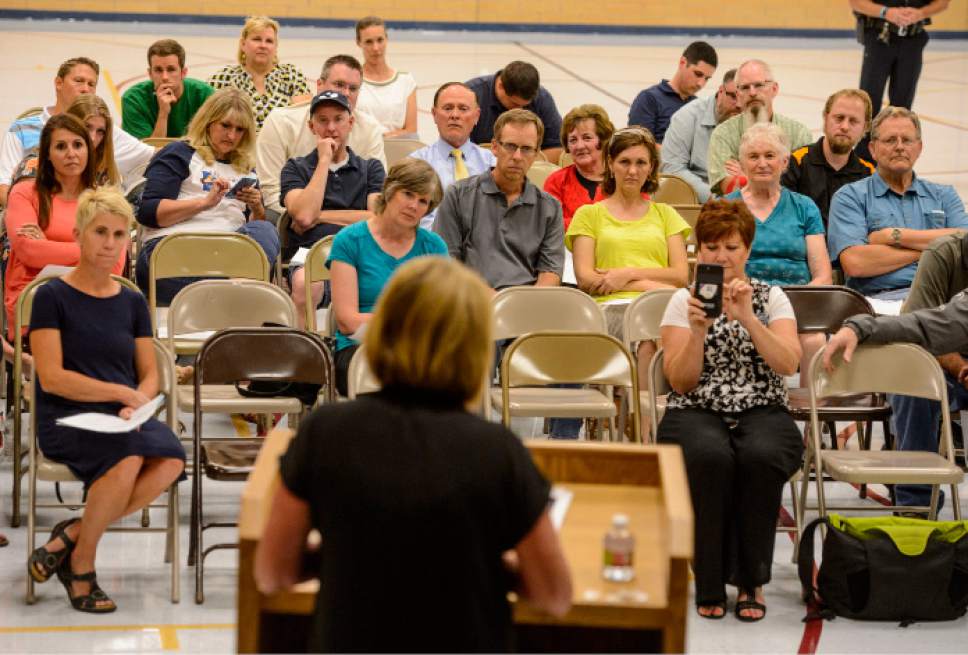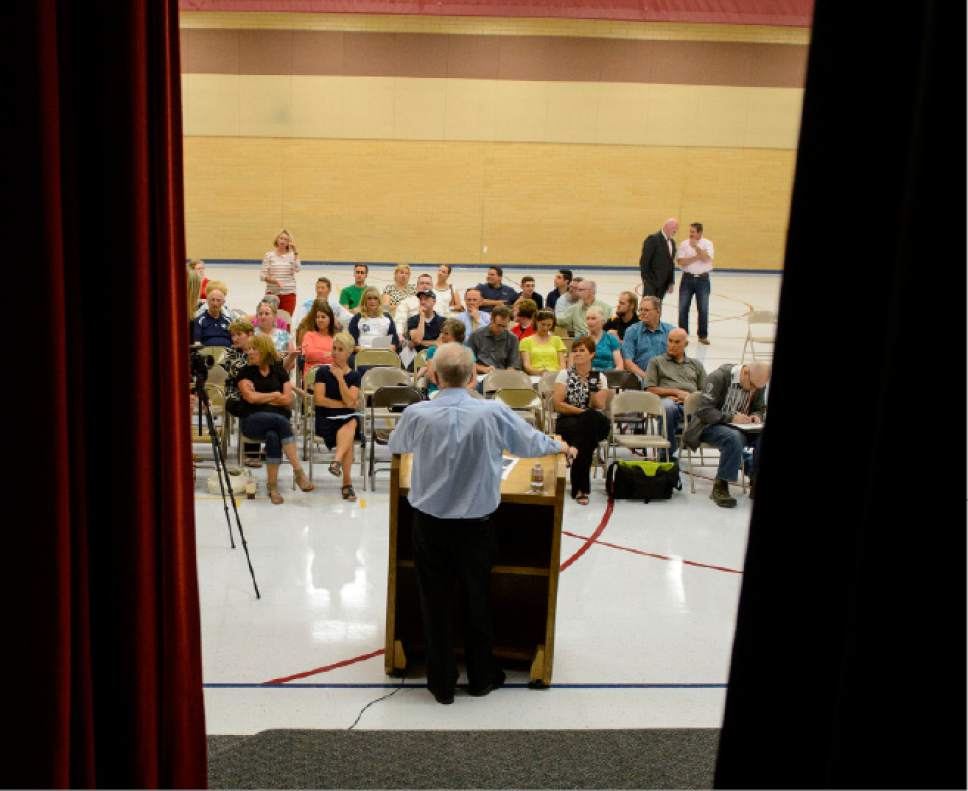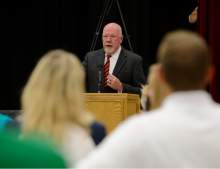This is an archived article that was published on sltrib.com in 2017, and information in the article may be outdated. It is provided only for personal research purposes and may not be reprinted.
Orem • When school starts for her three children each fall, Marci LeMonnier said Tuesday, she is asked by administrators to donate supplies like copy paper to compensate for strained budgets.
It's a shame, the Provo resident said, that Utah's last-in-the-nation school spending doesn't allow for even basic office supplies.
"We claim to love and cherish our children," she said, "but we are not willing to fund their education."
LeMonnier was among about 50 Utahns who met at Orem Elementary School to discuss the Our Schools Now initiative, which seeks to raise at least $700 million for public education through a combination of sales and income tax hikes.
The meeting was one of seven held simultaneously throughout the state Tuesday evening, as the initiative's organizers prepare to launch a petition drive to qualify for the November 2018 ballot.
"This is an opportunity for the public to share their opinion on the proposal," said Paul Thompson, an Our Schools Now volunteer who moderated the meeting.
Elementary teacher Brandon Engles described how he volunteers his time to advise school clubs and pays out-of-pocket to provide students with activities involving STEM — an acronym for science, technology, engineering and math. Additional funding, he said, would ease the burden on teachers and provide new and enhanced learning experiences.
"This initiative is going to help make sure our kids get what they need," he said.
The Orem meeting began with a 20-minute, unstructured question-and-answer period, followed by an hour of residents signing up for three-minute speaking slots.
Thompson initially struggled to answer questions from the audience, like whether revenue from the tax increases will be awarded to charter schools (it will) or to private and home schools (it will not).
At several points, local educators and representatives of the Utah Parent Teacher Association intervened to respond to audience members. When one man asked why Our Schools Now wasn't more focused on encouraging businesses to donate to schools, Alpine Board of Education member Jodee Sundberg said districts require stable revenue sources for budgeting.
"That's soft money," she said of education donations. "That's not money that we can count on every year."
Audience members were also critical of the initiative's organizers, which include Utah Jazz owner Gail Miller and Zions Bank President Scott Anderson.
Kip Jardine questioned why "multimillionaires and billionaires" were asking taxpayers to foot the bill for Our Schools Now without fully disclosing their own efforts to support public education.
"They're asking us for the money," Jardine said, "and they're not telling us much."
Other comments dismissed Our Schools Now's campaign materials as "propaganda" and critiqued the public education system as a socialist failure forced upon Utah's settlers as a requirement for statehood.
"The early Mormon pioneers never wanted public school," said Allan Hale. "In our public schools, we do not talk about God. We do not hear about God."
The cost of the initiative was also questioned, as was the notion that increased funding would translate to improved school performance. Our Schools Now originally announced that it would seek $750 million through an income tax increase of 0.875 percent, before updating the plans to include 0.5 percent increases of Utah's income tax and state sales tax.
While Our Schools Now describes the initiative as raising $700 million annually, the Governor's Office of Management and Budget estimates that, if fully implemented, it would carry a price tag of $865 million.
Utah County Democratic Party Vice Chairman Justin Anderson said financing schools on the backs of low- and fixed-income earners would create more problems than it solves.
"Good intentions do not make a bad policy a good one," he said.
And Parker Boyack said it's a "pipe dream" to expect higher taxes to help students because "the government sucks at spending money."
"We don't hate teachers. We don't think school is bad," Boyack said. "What we are against is wasteful spending. We know that it just will not work to throw money at the problem and hope it fixes itself."
But Steven Phelps, a teacher, questioned why Utahns are arguing over a tax of 50 cents out of $100 while schools are struggling to hire and retain educators. He said his school has an opening in its math department, which received zero applications, and that 70 high school students will likely be taught by an underqualified educator as a result.
"What you're asking teachers to do is, essentially, be the conduit of sacrifice," Phelps said. "At some point in time, we have to change the narrative and give us value."
Meanwhile, in Salt Lake County, the majority of the nearly 80 attendees filed into Wasatch Elementary School to support the measure. Cheers and applause filled the school's auditorium after almost every positive comment or story shared about how the initiative could help education.
Teachers and administrators spanning districts across the Salt Lake Valley shared stories of overflowing classrooms and the need for more resources to help them do their jobs well.
Jennifer Boehme, a former teacher, described how additional funding could have helped address the high turnover rate she has experience in her classrooms throughout her career.
"In order to help students, we need more support in the classroom," Boehme, now UniServ Director, said. "A full-time aide or a way to reduce classroom sizes are how additional funds would help provide opportunities and support for our most vulnerable students."
State Rep. Carol Spackman Moss, D-Salt Lake City, took the microphone during the meeting, offering her fervent support of the measure. As a former teacher, she said investing in education is the only way to improve as a state.
"We do all kinds of things to be the best-managed state, yet we have the lowest funding for education," she told the crowd. "If we want to be the top-managed state with one of the best economies, we have to have a very well-educated population, and that will only be done with top-notch teachers and the resources they need."
Some in attendance in Salt Lake City raised their concerns about how districts will be held accountable for their use of new funding. Billy Hesterman, vice president of the Utah Taxpayers Association, isn't confident that school boards and principals will funnel the money to the best improvement efforts. He said he is concerned about the disparity in funding among districts in areas with higher property values.
"We also need to look at ways to equalize funding for all students in Utah," Hesterman added after the hearing. "We need to ask the question of if we can do something to equalize the disparity and make sure all Utah students are treated equal, not just the ones whose parents are a little more well-off than the rest."
Hesterman's boss, Utah Taxpayers Association President and Draper Republican Sen. Howard Stephenson, was present at the Orem meeting, along with Rep. Tim Quinn, R-Heber City.
Stephenson described an inability of some Utah school districts to compete with those that collect more revenue from local property taxes.
He said Our Schools Now would be more palatable if it addressed budget inequality among districts — a cause he advocates for frequently in the Legislature — but was cut off and chastised by members of the audience for exceeding the three minutes allotted to speakers.
And, in one heated exchange, a woman at the Orem meeting described Utah lawmakers as being "biased" against citizen initiatives, prompting a response from Quinn.
"You don't know me, and I don't know you," the freshman representative said.
Our Schools Now plans to launch its petition drive in August. In order to qualify for the ballot, the initiative must secure more than 113,000 signatures from voters in at least 26 of Utah's 29 Senate districts.
Twitter: @bjaminwood, @kelgiffo







